HRMT20024: Talent Management Strategies in Global Manufacturing
VerifiedAdded on 2023/06/14
|14
|3134
|455
Annotated Bibliography
AI Summary
This annotated bibliography focuses on talent management within the global manufacturing sector, particularly in car manufacturing organizations. It includes five peer-reviewed journal articles covering topics such as talent management using fuzzy logic approaches, succession planning's impact on small and medium-sized enterprises, talent management in India and China, human resource diversity management, and determinants of quality management in New Zealand. Each article is summarized and critically analyzed, highlighting its relevance to attracting and retaining talent, developing employee performance plans, and understanding the influence of regional factors on talent management strategies. The bibliography aims to provide insights into effective HRM practices for retaining talent and enhancing organizational performance in the manufacturing industry.
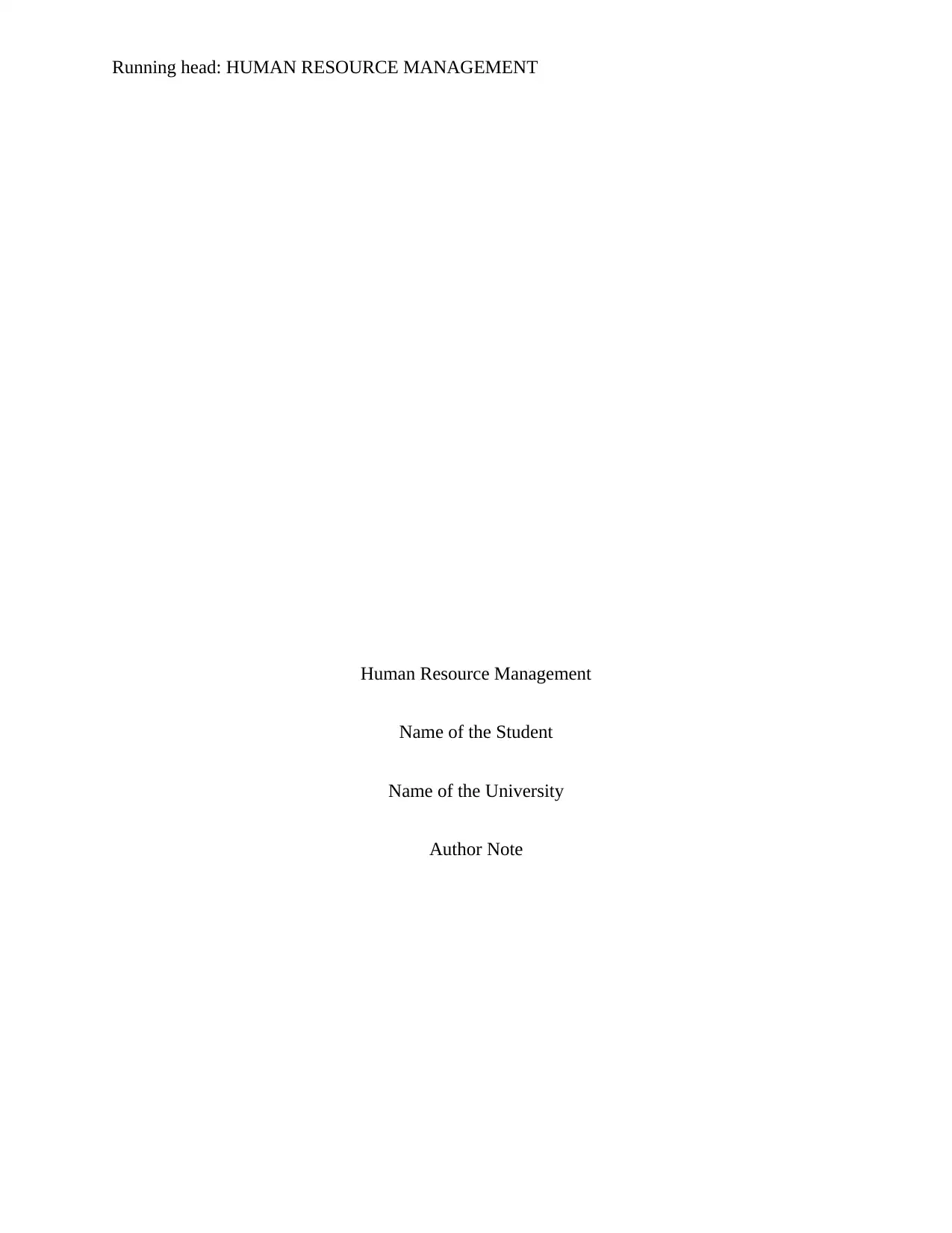
Running head: HUMAN RESOURCE MANAGEMENT
Human Resource Management
Name of the Student
Name of the University
Author Note
Human Resource Management
Name of the Student
Name of the University
Author Note
Paraphrase This Document
Need a fresh take? Get an instant paraphrase of this document with our AI Paraphraser

1HUMAN RESOURCE MANAGEMENT
Introduction The following annotated bibliography includes the global manufacturing
sector; particularly the car manufacturing organizations. For this annotated
bibliography, I have chosen five different peer reviewed journals articles and
each them is on talent management in manufacturing sector. The first article is
about the talent management in manufacturing system using fuzzy logic
approaches, which mainly talks about how potentials talents in the organization
can be retained and managed using computing approaches where truth of fact
is based on its degree rather than only one variable. Likewise, the second
article which I have chosen is about succession planning and its impact on
small micro and medium size organization in the manufacturing sector.
Succession planning is a part of talent management which usually influence the
employees of small and medium size organizations. The third article is about
talent management in India and China; in this article, the authors have
presented a clear comparison of management perception and practices but the
major theme is talent management. The fourth article is about human resource
diversity management in the manufacturing sector and I have chosen this
article because diversity management is also a part of talent management.
Organizational members come from a different cultural backgrounds; thereby,
it is mandatory to identify how those members can be managed in a workplace.
Similarly, the fifth article is about determinants of quality management in the
manufacturing sector of New Zealand.
Article 1 Full Reference [“Karatop, B., Kubat, C. & Uygun, Ö., (2015). Talent
management in manufacturing system using fuzzy logic
Introduction The following annotated bibliography includes the global manufacturing
sector; particularly the car manufacturing organizations. For this annotated
bibliography, I have chosen five different peer reviewed journals articles and
each them is on talent management in manufacturing sector. The first article is
about the talent management in manufacturing system using fuzzy logic
approaches, which mainly talks about how potentials talents in the organization
can be retained and managed using computing approaches where truth of fact
is based on its degree rather than only one variable. Likewise, the second
article which I have chosen is about succession planning and its impact on
small micro and medium size organization in the manufacturing sector.
Succession planning is a part of talent management which usually influence the
employees of small and medium size organizations. The third article is about
talent management in India and China; in this article, the authors have
presented a clear comparison of management perception and practices but the
major theme is talent management. The fourth article is about human resource
diversity management in the manufacturing sector and I have chosen this
article because diversity management is also a part of talent management.
Organizational members come from a different cultural backgrounds; thereby,
it is mandatory to identify how those members can be managed in a workplace.
Similarly, the fifth article is about determinants of quality management in the
manufacturing sector of New Zealand.
Article 1 Full Reference [“Karatop, B., Kubat, C. & Uygun, Ö., (2015). Talent
management in manufacturing system using fuzzy logic
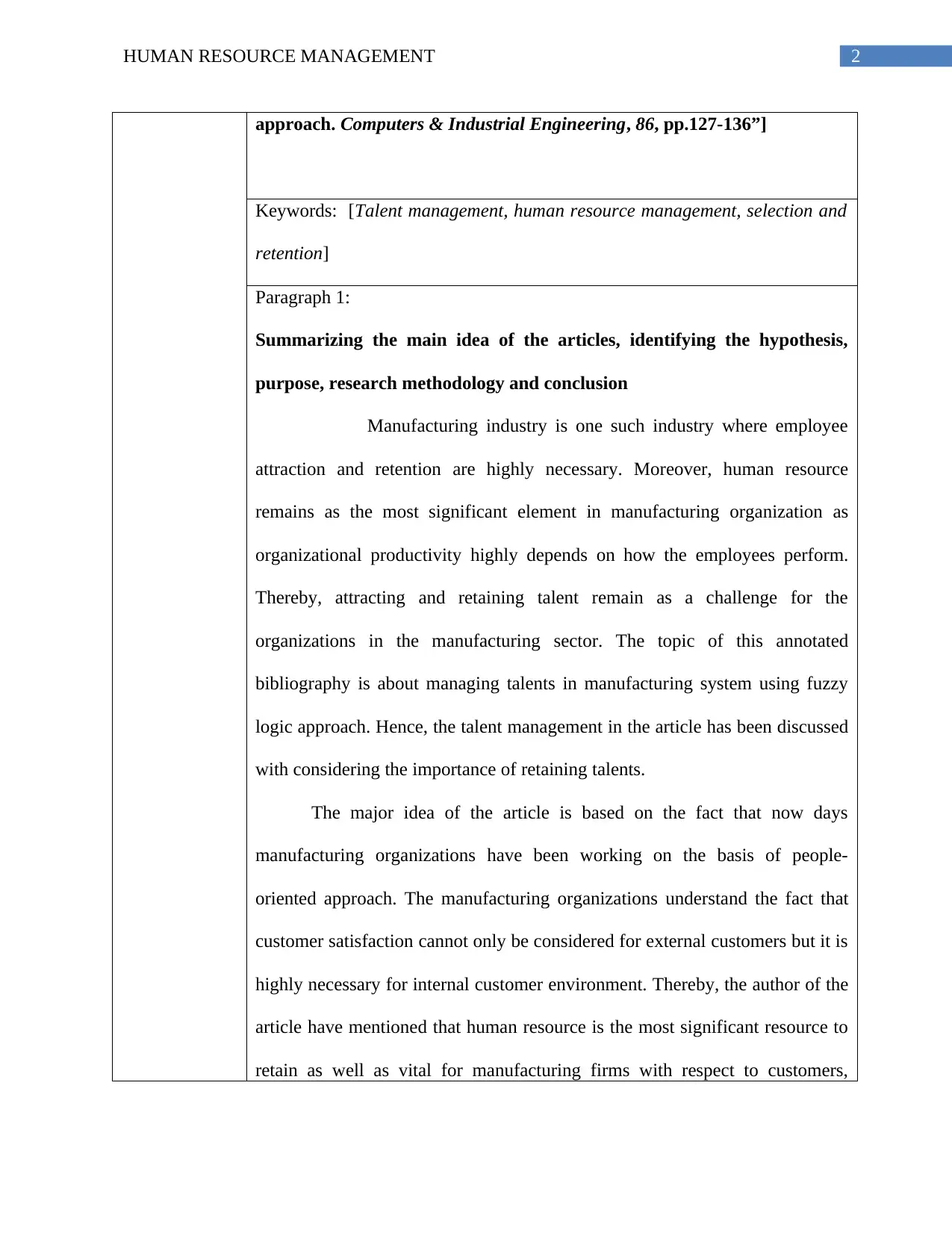
2HUMAN RESOURCE MANAGEMENT
approach. Computers & Industrial Engineering, 86, pp.127-136”]
Keywords: [Talent management, human resource management, selection and
retention]
Paragraph 1:
Summarizing the main idea of the articles, identifying the hypothesis,
purpose, research methodology and conclusion
Manufacturing industry is one such industry where employee
attraction and retention are highly necessary. Moreover, human resource
remains as the most significant element in manufacturing organization as
organizational productivity highly depends on how the employees perform.
Thereby, attracting and retaining talent remain as a challenge for the
organizations in the manufacturing sector. The topic of this annotated
bibliography is about managing talents in manufacturing system using fuzzy
logic approach. Hence, the talent management in the article has been discussed
with considering the importance of retaining talents.
The major idea of the article is based on the fact that now days
manufacturing organizations have been working on the basis of people-
oriented approach. The manufacturing organizations understand the fact that
customer satisfaction cannot only be considered for external customers but it is
highly necessary for internal customer environment. Thereby, the author of the
article have mentioned that human resource is the most significant resource to
retain as well as vital for manufacturing firms with respect to customers,
approach. Computers & Industrial Engineering, 86, pp.127-136”]
Keywords: [Talent management, human resource management, selection and
retention]
Paragraph 1:
Summarizing the main idea of the articles, identifying the hypothesis,
purpose, research methodology and conclusion
Manufacturing industry is one such industry where employee
attraction and retention are highly necessary. Moreover, human resource
remains as the most significant element in manufacturing organization as
organizational productivity highly depends on how the employees perform.
Thereby, attracting and retaining talent remain as a challenge for the
organizations in the manufacturing sector. The topic of this annotated
bibliography is about managing talents in manufacturing system using fuzzy
logic approach. Hence, the talent management in the article has been discussed
with considering the importance of retaining talents.
The major idea of the article is based on the fact that now days
manufacturing organizations have been working on the basis of people-
oriented approach. The manufacturing organizations understand the fact that
customer satisfaction cannot only be considered for external customers but it is
highly necessary for internal customer environment. Thereby, the author of the
article have mentioned that human resource is the most significant resource to
retain as well as vital for manufacturing firms with respect to customers,
⊘ This is a preview!⊘
Do you want full access?
Subscribe today to unlock all pages.

Trusted by 1+ million students worldwide
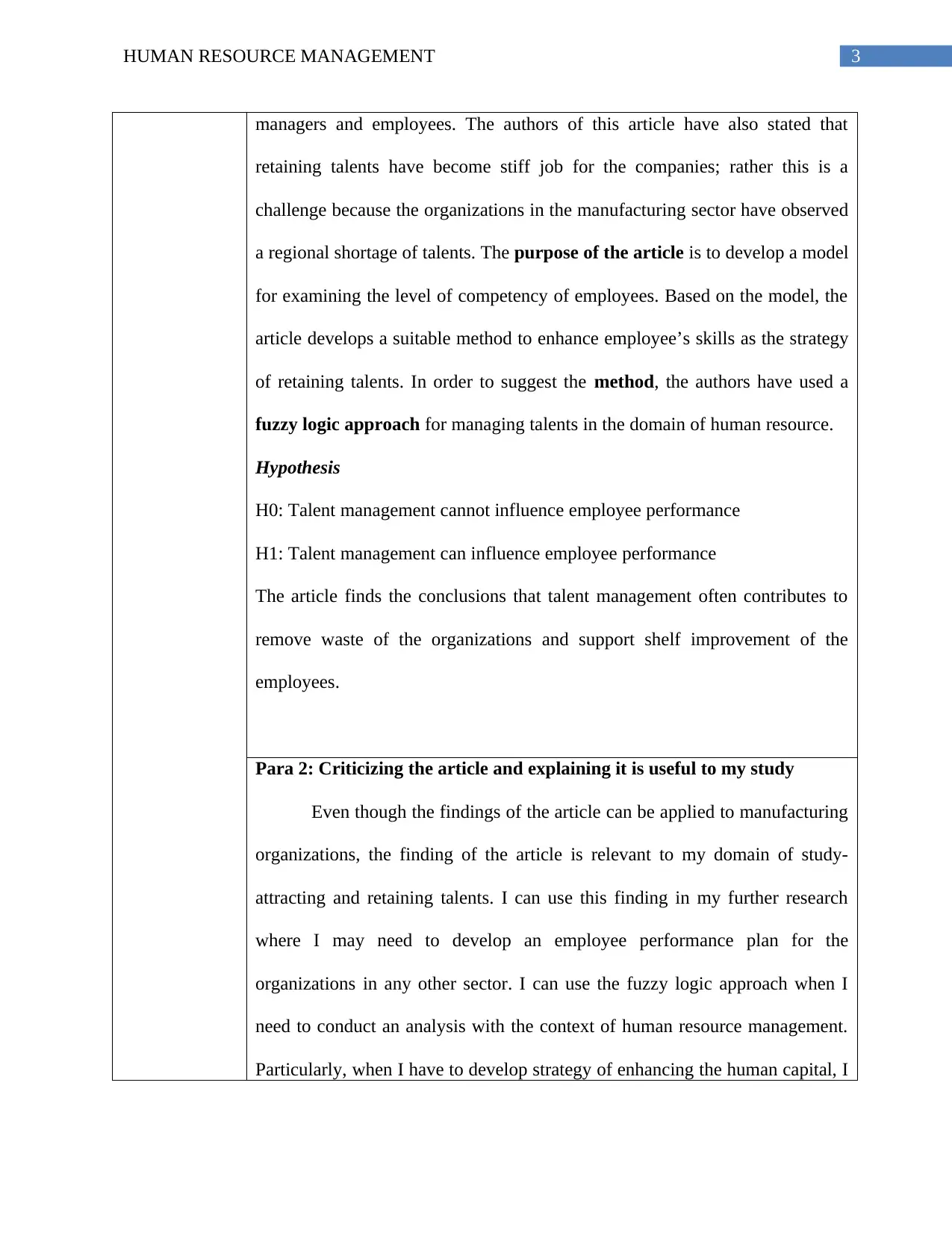
3HUMAN RESOURCE MANAGEMENT
managers and employees. The authors of this article have also stated that
retaining talents have become stiff job for the companies; rather this is a
challenge because the organizations in the manufacturing sector have observed
a regional shortage of talents. The purpose of the article is to develop a model
for examining the level of competency of employees. Based on the model, the
article develops a suitable method to enhance employee’s skills as the strategy
of retaining talents. In order to suggest the method, the authors have used a
fuzzy logic approach for managing talents in the domain of human resource.
Hypothesis
H0: Talent management cannot influence employee performance
H1: Talent management can influence employee performance
The article finds the conclusions that talent management often contributes to
remove waste of the organizations and support shelf improvement of the
employees.
Para 2: Criticizing the article and explaining it is useful to my study
Even though the findings of the article can be applied to manufacturing
organizations, the finding of the article is relevant to my domain of study-
attracting and retaining talents. I can use this finding in my further research
where I may need to develop an employee performance plan for the
organizations in any other sector. I can use the fuzzy logic approach when I
need to conduct an analysis with the context of human resource management.
Particularly, when I have to develop strategy of enhancing the human capital, I
managers and employees. The authors of this article have also stated that
retaining talents have become stiff job for the companies; rather this is a
challenge because the organizations in the manufacturing sector have observed
a regional shortage of talents. The purpose of the article is to develop a model
for examining the level of competency of employees. Based on the model, the
article develops a suitable method to enhance employee’s skills as the strategy
of retaining talents. In order to suggest the method, the authors have used a
fuzzy logic approach for managing talents in the domain of human resource.
Hypothesis
H0: Talent management cannot influence employee performance
H1: Talent management can influence employee performance
The article finds the conclusions that talent management often contributes to
remove waste of the organizations and support shelf improvement of the
employees.
Para 2: Criticizing the article and explaining it is useful to my study
Even though the findings of the article can be applied to manufacturing
organizations, the finding of the article is relevant to my domain of study-
attracting and retaining talents. I can use this finding in my further research
where I may need to develop an employee performance plan for the
organizations in any other sector. I can use the fuzzy logic approach when I
need to conduct an analysis with the context of human resource management.
Particularly, when I have to develop strategy of enhancing the human capital, I
Paraphrase This Document
Need a fresh take? Get an instant paraphrase of this document with our AI Paraphraser
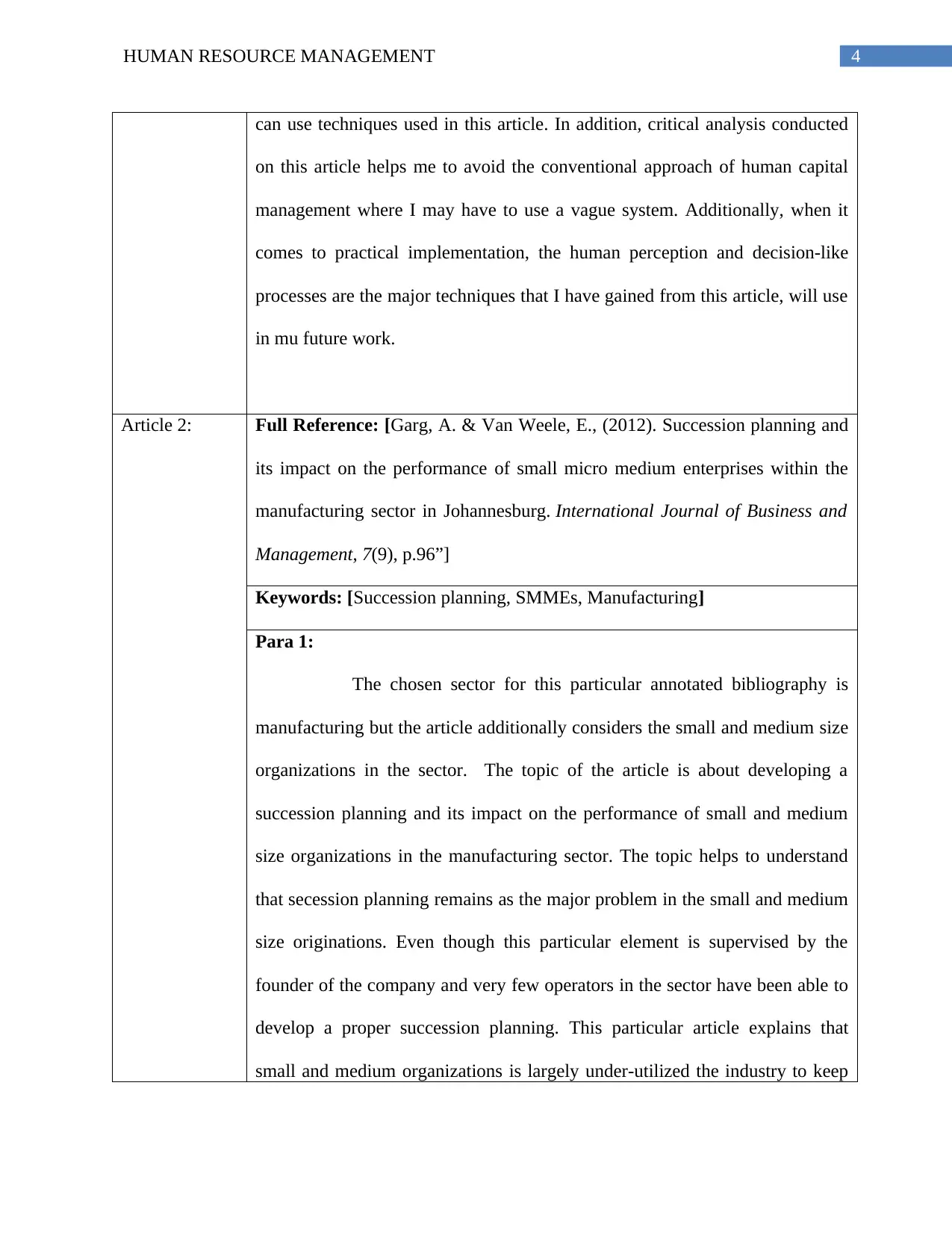
4HUMAN RESOURCE MANAGEMENT
can use techniques used in this article. In addition, critical analysis conducted
on this article helps me to avoid the conventional approach of human capital
management where I may have to use a vague system. Additionally, when it
comes to practical implementation, the human perception and decision-like
processes are the major techniques that I have gained from this article, will use
in mu future work.
Article 2: Full Reference: [Garg, A. & Van Weele, E., (2012). Succession planning and
its impact on the performance of small micro medium enterprises within the
manufacturing sector in Johannesburg. International Journal of Business and
Management, 7(9), p.96”]
Keywords: [Succession planning, SMMEs, Manufacturing]
Para 1:
The chosen sector for this particular annotated bibliography is
manufacturing but the article additionally considers the small and medium size
organizations in the sector. The topic of the article is about developing a
succession planning and its impact on the performance of small and medium
size organizations in the manufacturing sector. The topic helps to understand
that secession planning remains as the major problem in the small and medium
size originations. Even though this particular element is supervised by the
founder of the company and very few operators in the sector have been able to
develop a proper succession planning. This particular article explains that
small and medium organizations is largely under-utilized the industry to keep
can use techniques used in this article. In addition, critical analysis conducted
on this article helps me to avoid the conventional approach of human capital
management where I may have to use a vague system. Additionally, when it
comes to practical implementation, the human perception and decision-like
processes are the major techniques that I have gained from this article, will use
in mu future work.
Article 2: Full Reference: [Garg, A. & Van Weele, E., (2012). Succession planning and
its impact on the performance of small micro medium enterprises within the
manufacturing sector in Johannesburg. International Journal of Business and
Management, 7(9), p.96”]
Keywords: [Succession planning, SMMEs, Manufacturing]
Para 1:
The chosen sector for this particular annotated bibliography is
manufacturing but the article additionally considers the small and medium size
organizations in the sector. The topic of the article is about developing a
succession planning and its impact on the performance of small and medium
size organizations in the manufacturing sector. The topic helps to understand
that secession planning remains as the major problem in the small and medium
size originations. Even though this particular element is supervised by the
founder of the company and very few operators in the sector have been able to
develop a proper succession planning. This particular article explains that
small and medium organizations is largely under-utilized the industry to keep
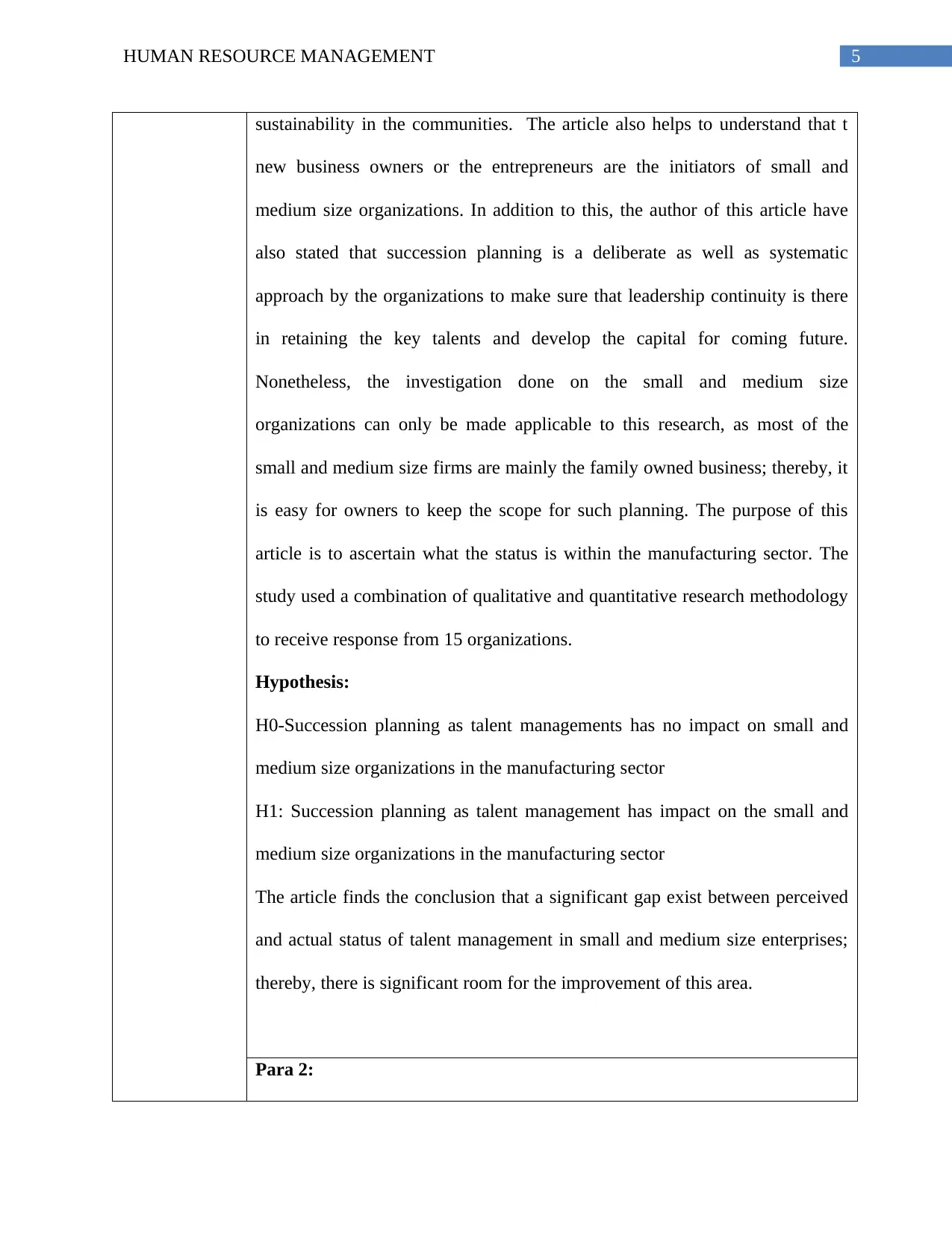
5HUMAN RESOURCE MANAGEMENT
sustainability in the communities. The article also helps to understand that t
new business owners or the entrepreneurs are the initiators of small and
medium size organizations. In addition to this, the author of this article have
also stated that succession planning is a deliberate as well as systematic
approach by the organizations to make sure that leadership continuity is there
in retaining the key talents and develop the capital for coming future.
Nonetheless, the investigation done on the small and medium size
organizations can only be made applicable to this research, as most of the
small and medium size firms are mainly the family owned business; thereby, it
is easy for owners to keep the scope for such planning. The purpose of this
article is to ascertain what the status is within the manufacturing sector. The
study used a combination of qualitative and quantitative research methodology
to receive response from 15 organizations.
Hypothesis:
H0-Succession planning as talent managements has no impact on small and
medium size organizations in the manufacturing sector
H1: Succession planning as talent management has impact on the small and
medium size organizations in the manufacturing sector
The article finds the conclusion that a significant gap exist between perceived
and actual status of talent management in small and medium size enterprises;
thereby, there is significant room for the improvement of this area.
Para 2:
sustainability in the communities. The article also helps to understand that t
new business owners or the entrepreneurs are the initiators of small and
medium size organizations. In addition to this, the author of this article have
also stated that succession planning is a deliberate as well as systematic
approach by the organizations to make sure that leadership continuity is there
in retaining the key talents and develop the capital for coming future.
Nonetheless, the investigation done on the small and medium size
organizations can only be made applicable to this research, as most of the
small and medium size firms are mainly the family owned business; thereby, it
is easy for owners to keep the scope for such planning. The purpose of this
article is to ascertain what the status is within the manufacturing sector. The
study used a combination of qualitative and quantitative research methodology
to receive response from 15 organizations.
Hypothesis:
H0-Succession planning as talent managements has no impact on small and
medium size organizations in the manufacturing sector
H1: Succession planning as talent management has impact on the small and
medium size organizations in the manufacturing sector
The article finds the conclusion that a significant gap exist between perceived
and actual status of talent management in small and medium size enterprises;
thereby, there is significant room for the improvement of this area.
Para 2:
⊘ This is a preview!⊘
Do you want full access?
Subscribe today to unlock all pages.

Trusted by 1+ million students worldwide
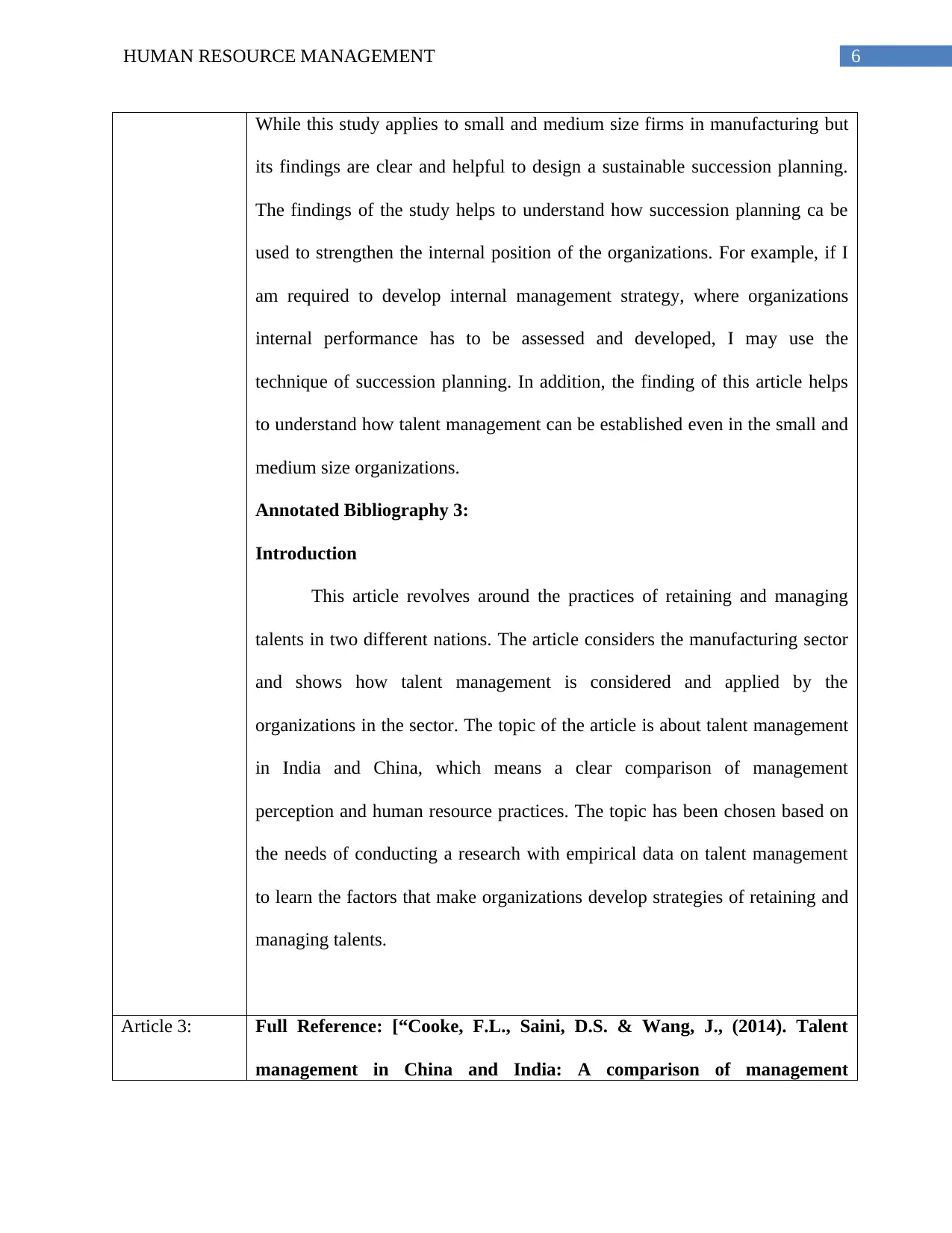
6HUMAN RESOURCE MANAGEMENT
While this study applies to small and medium size firms in manufacturing but
its findings are clear and helpful to design a sustainable succession planning.
The findings of the study helps to understand how succession planning ca be
used to strengthen the internal position of the organizations. For example, if I
am required to develop internal management strategy, where organizations
internal performance has to be assessed and developed, I may use the
technique of succession planning. In addition, the finding of this article helps
to understand how talent management can be established even in the small and
medium size organizations.
Annotated Bibliography 3:
Introduction
This article revolves around the practices of retaining and managing
talents in two different nations. The article considers the manufacturing sector
and shows how talent management is considered and applied by the
organizations in the sector. The topic of the article is about talent management
in India and China, which means a clear comparison of management
perception and human resource practices. The topic has been chosen based on
the needs of conducting a research with empirical data on talent management
to learn the factors that make organizations develop strategies of retaining and
managing talents.
Article 3: Full Reference: [“Cooke, F.L., Saini, D.S. & Wang, J., (2014). Talent
management in China and India: A comparison of management
While this study applies to small and medium size firms in manufacturing but
its findings are clear and helpful to design a sustainable succession planning.
The findings of the study helps to understand how succession planning ca be
used to strengthen the internal position of the organizations. For example, if I
am required to develop internal management strategy, where organizations
internal performance has to be assessed and developed, I may use the
technique of succession planning. In addition, the finding of this article helps
to understand how talent management can be established even in the small and
medium size organizations.
Annotated Bibliography 3:
Introduction
This article revolves around the practices of retaining and managing
talents in two different nations. The article considers the manufacturing sector
and shows how talent management is considered and applied by the
organizations in the sector. The topic of the article is about talent management
in India and China, which means a clear comparison of management
perception and human resource practices. The topic has been chosen based on
the needs of conducting a research with empirical data on talent management
to learn the factors that make organizations develop strategies of retaining and
managing talents.
Article 3: Full Reference: [“Cooke, F.L., Saini, D.S. & Wang, J., (2014). Talent
management in China and India: A comparison of management
Paraphrase This Document
Need a fresh take? Get an instant paraphrase of this document with our AI Paraphraser

7HUMAN RESOURCE MANAGEMENT
perceptions and human resource practices. Journal of World
Business, 49(2), pp.225-235.”]
Keywords: [Talent management, Rewards, Culture and Strategic HRM]
Para 1:
This article revolves around the practices of retaining and managing talents in
two different nations. The article considers the manufacturing sector and shows
how talent management is considered and applied by the organizations in the
sector. The topic of the article is about talent management in India and China,
which means a clear comparison of management perception and human
resource practices. The topic has been chosen based on the needs of conducting
a research with empirical data on talent management to learn the factors that
make organizations develop strategies of retaining and managing talents. The
article explains that talent management have widely been conducted in the
context of a develop economies, while small of research made a significant
contrition in enhancing and advancing knowledge on talent management. The
study particular signifies the fact that the concept of holding or retaining talent
and the extent to which these concepts or perceptions could be similar or
different is the major gap of the research. This is unclear due to the reason that
China and India hold almost one third of the population and both the nations
are going ahead with young and educated populations. The purpose of the
article is to examine and identify how Chin and India considers ad applies
talent management.
Para 2:
perceptions and human resource practices. Journal of World
Business, 49(2), pp.225-235.”]
Keywords: [Talent management, Rewards, Culture and Strategic HRM]
Para 1:
This article revolves around the practices of retaining and managing talents in
two different nations. The article considers the manufacturing sector and shows
how talent management is considered and applied by the organizations in the
sector. The topic of the article is about talent management in India and China,
which means a clear comparison of management perception and human
resource practices. The topic has been chosen based on the needs of conducting
a research with empirical data on talent management to learn the factors that
make organizations develop strategies of retaining and managing talents. The
article explains that talent management have widely been conducted in the
context of a develop economies, while small of research made a significant
contrition in enhancing and advancing knowledge on talent management. The
study particular signifies the fact that the concept of holding or retaining talent
and the extent to which these concepts or perceptions could be similar or
different is the major gap of the research. This is unclear due to the reason that
China and India hold almost one third of the population and both the nations
are going ahead with young and educated populations. The purpose of the
article is to examine and identify how Chin and India considers ad applies
talent management.
Para 2:
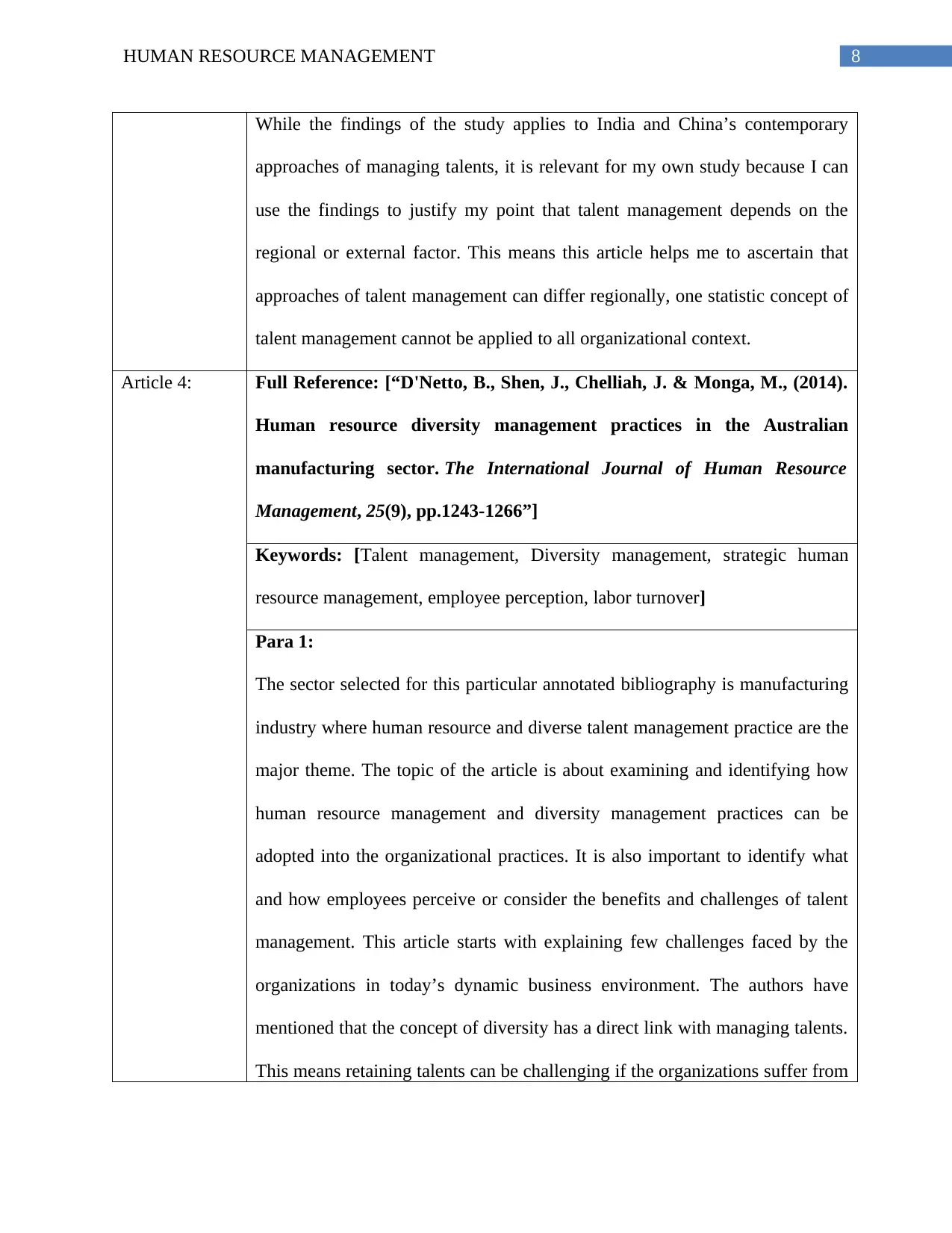
8HUMAN RESOURCE MANAGEMENT
While the findings of the study applies to India and China’s contemporary
approaches of managing talents, it is relevant for my own study because I can
use the findings to justify my point that talent management depends on the
regional or external factor. This means this article helps me to ascertain that
approaches of talent management can differ regionally, one statistic concept of
talent management cannot be applied to all organizational context.
Article 4: Full Reference: [“D'Netto, B., Shen, J., Chelliah, J. & Monga, M., (2014).
Human resource diversity management practices in the Australian
manufacturing sector. The International Journal of Human Resource
Management, 25(9), pp.1243-1266”]
Keywords: [Talent management, Diversity management, strategic human
resource management, employee perception, labor turnover]
Para 1:
The sector selected for this particular annotated bibliography is manufacturing
industry where human resource and diverse talent management practice are the
major theme. The topic of the article is about examining and identifying how
human resource management and diversity management practices can be
adopted into the organizational practices. It is also important to identify what
and how employees perceive or consider the benefits and challenges of talent
management. This article starts with explaining few challenges faced by the
organizations in today’s dynamic business environment. The authors have
mentioned that the concept of diversity has a direct link with managing talents.
This means retaining talents can be challenging if the organizations suffer from
While the findings of the study applies to India and China’s contemporary
approaches of managing talents, it is relevant for my own study because I can
use the findings to justify my point that talent management depends on the
regional or external factor. This means this article helps me to ascertain that
approaches of talent management can differ regionally, one statistic concept of
talent management cannot be applied to all organizational context.
Article 4: Full Reference: [“D'Netto, B., Shen, J., Chelliah, J. & Monga, M., (2014).
Human resource diversity management practices in the Australian
manufacturing sector. The International Journal of Human Resource
Management, 25(9), pp.1243-1266”]
Keywords: [Talent management, Diversity management, strategic human
resource management, employee perception, labor turnover]
Para 1:
The sector selected for this particular annotated bibliography is manufacturing
industry where human resource and diverse talent management practice are the
major theme. The topic of the article is about examining and identifying how
human resource management and diversity management practices can be
adopted into the organizational practices. It is also important to identify what
and how employees perceive or consider the benefits and challenges of talent
management. This article starts with explaining few challenges faced by the
organizations in today’s dynamic business environment. The authors have
mentioned that the concept of diversity has a direct link with managing talents.
This means retaining talents can be challenging if the organizations suffer from
⊘ This is a preview!⊘
Do you want full access?
Subscribe today to unlock all pages.

Trusted by 1+ million students worldwide

9HUMAN RESOURCE MANAGEMENT
workplace diversify issue. Moreover, the empirical data provided in the article
helps to understand that employees do not prefer to work with organizations
where the workers are not treated equally. The purpose of the study is to
develop an effective human resource and diversity management practices
through which the talents can be retained and attracted. The authors have
found that discrimination of talents do not exist in Australian manufacturing
sector. However, from the article, it is also found that organizations in the
manufacturing sector of Australia tend to adopt a “legalistic compliance
approach. Organizations did not adopt any effective HR diversity management
practice. The article used primary data collection methods, where the
employees of few manufacturing organizations have been considered.
Para 2:
Even though the findings of the study is applicable to Australian
manufacturing industry but the findings can be used to my field of study,
where I need to analyze how improper diversity management practices create
challenges in attracting and managing the key talents in the organizations.
Moreover, by using this finding, I can conduct a research about how diversity
management can be a significant requirement or opportunity for retaining the
key talent in the organizations.
Article 5: Full Reference: [Agarwal, R., Green, R., Brown, P.J., Tan, H. &
Randhawa, K., (2013). Determinants of quality management practices: An
empirical study of New Zealand manufacturing firms. International
Journal of Production Economics, 142(1), pp.130-145”.]
workplace diversify issue. Moreover, the empirical data provided in the article
helps to understand that employees do not prefer to work with organizations
where the workers are not treated equally. The purpose of the study is to
develop an effective human resource and diversity management practices
through which the talents can be retained and attracted. The authors have
found that discrimination of talents do not exist in Australian manufacturing
sector. However, from the article, it is also found that organizations in the
manufacturing sector of Australia tend to adopt a “legalistic compliance
approach. Organizations did not adopt any effective HR diversity management
practice. The article used primary data collection methods, where the
employees of few manufacturing organizations have been considered.
Para 2:
Even though the findings of the study is applicable to Australian
manufacturing industry but the findings can be used to my field of study,
where I need to analyze how improper diversity management practices create
challenges in attracting and managing the key talents in the organizations.
Moreover, by using this finding, I can conduct a research about how diversity
management can be a significant requirement or opportunity for retaining the
key talent in the organizations.
Article 5: Full Reference: [Agarwal, R., Green, R., Brown, P.J., Tan, H. &
Randhawa, K., (2013). Determinants of quality management practices: An
empirical study of New Zealand manufacturing firms. International
Journal of Production Economics, 142(1), pp.130-145”.]
Paraphrase This Document
Need a fresh take? Get an instant paraphrase of this document with our AI Paraphraser

10HUMAN RESOURCE MANAGEMENT
Keyword: [Performance management, talent management, employee retention
policies and reward structure]
Para 1:
This article considers all sizes of organizations in the manufacturing sector of
New Zealand. The topic of this article is about finding out the determinants of
quality management practices. The determinants of quality management are
highly related to retention and attraction of talents because if the organizations
are not able to keep or hold the key talents, it will not be able to keep a desired
quality of services. The topic of the article also considers some related the
theme such as the importance of goal setting, performance management, and
reward structure and employee promotions. The article explains that the
significance of goal setting, performance management system and employee
promotion in an effective quality management practices. The article
particularly mentions that firms in the manufacturing sector should adopt
broad-based management practices. According to the author, if there are
management practices that include the potential or capacity to increase
productivity globally of the manufacturing organizations, their late adoption by
all organizations in such environment or markets often remains as a pertinent
question. The article used a mixed research method where both qualitative and
quantitative data collection techniques have been used. The purpose of the
study is to determine the potential determinants of quality management. The
article reaches the conclusion that management practice score is widely
Keyword: [Performance management, talent management, employee retention
policies and reward structure]
Para 1:
This article considers all sizes of organizations in the manufacturing sector of
New Zealand. The topic of this article is about finding out the determinants of
quality management practices. The determinants of quality management are
highly related to retention and attraction of talents because if the organizations
are not able to keep or hold the key talents, it will not be able to keep a desired
quality of services. The topic of the article also considers some related the
theme such as the importance of goal setting, performance management, and
reward structure and employee promotions. The article explains that the
significance of goal setting, performance management system and employee
promotion in an effective quality management practices. The article
particularly mentions that firms in the manufacturing sector should adopt
broad-based management practices. According to the author, if there are
management practices that include the potential or capacity to increase
productivity globally of the manufacturing organizations, their late adoption by
all organizations in such environment or markets often remains as a pertinent
question. The article used a mixed research method where both qualitative and
quantitative data collection techniques have been used. The purpose of the
study is to determine the potential determinants of quality management. The
article reaches the conclusion that management practice score is widely

11HUMAN RESOURCE MANAGEMENT
associated with different productivity performance and other areas; and these
MPS acquire relevant into information about the management practices. The
size of firm, ownership structure and range of education could affect the
strategies of retaining talents.
Para 2:
The findings of this article are relevant to my study areas, because the findings
help me to broaden my focus to some extending areas such as organizational
structure and ownership. If I conduct a comparative research between
organizational culture, leadership and talent management, then this findings
will help me to analyze how organizational structure impacts on retention
strategies of the organization.
associated with different productivity performance and other areas; and these
MPS acquire relevant into information about the management practices. The
size of firm, ownership structure and range of education could affect the
strategies of retaining talents.
Para 2:
The findings of this article are relevant to my study areas, because the findings
help me to broaden my focus to some extending areas such as organizational
structure and ownership. If I conduct a comparative research between
organizational culture, leadership and talent management, then this findings
will help me to analyze how organizational structure impacts on retention
strategies of the organization.
⊘ This is a preview!⊘
Do you want full access?
Subscribe today to unlock all pages.

Trusted by 1+ million students worldwide
1 out of 14
Related Documents
Your All-in-One AI-Powered Toolkit for Academic Success.
+13062052269
info@desklib.com
Available 24*7 on WhatsApp / Email
![[object Object]](/_next/static/media/star-bottom.7253800d.svg)
Unlock your academic potential
Copyright © 2020–2025 A2Z Services. All Rights Reserved. Developed and managed by ZUCOL.





